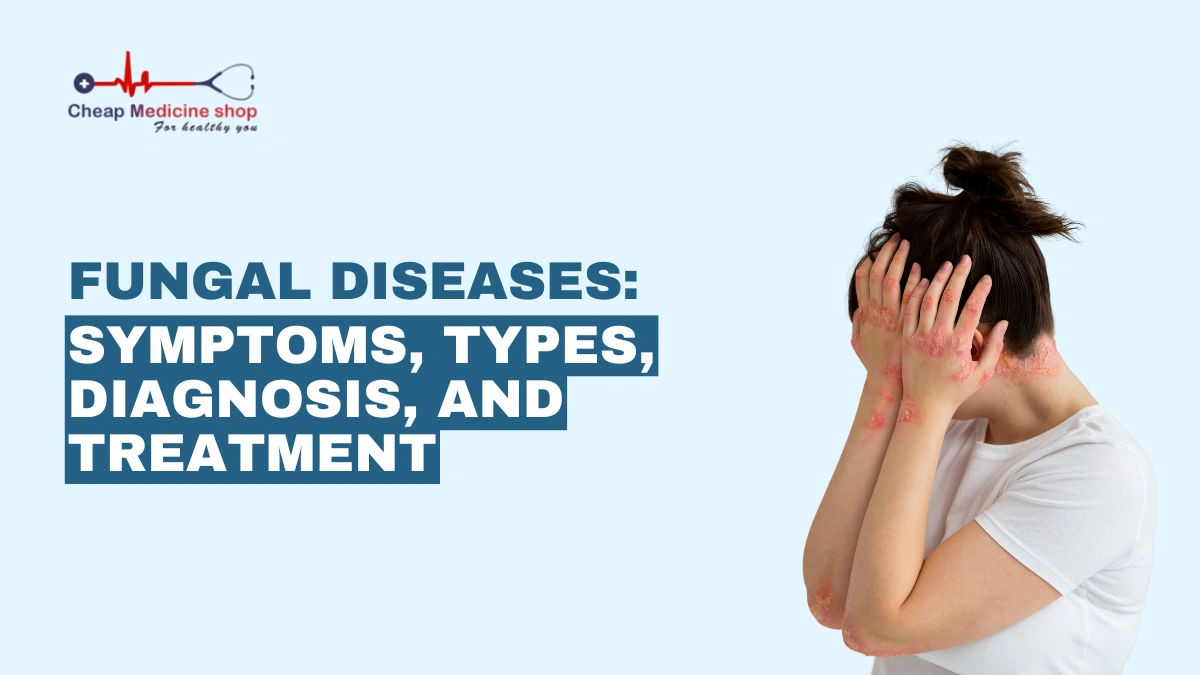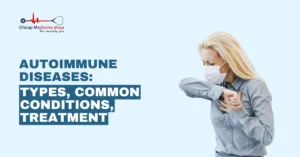Fungal diseases, also known as Mycoses, are diseases caused by fungi. They can affect almost any part of the body, including the lungs, skin, eyes, and internal organs. The diseases can range from mild skin conditions to severe systemic diseases that affect the whole system.
Millions worldwide suffer from fungal diseases each year. Serious infections cause over 1.5 million deaths annually, especially among people with weak immunity.
Early recognition and treatment are crucial in reducing such incidents and complications. This article covers how fungal diseases are classified, their causes, primary symptoms, diagnosis methods, treatment options, and prevention strategies to protect your health.
What are fungal diseases and how do they spread?
A fungal disease is simply any disease caused by a fungus. It occurs when pathogenic (disease-causing) fungi invade and multiply in human tissues. While fungi naturally exist on skin and mucosal surfaces (moist membranes of the body’s internal cavities), infections or diseases occur when their growth goes unchecked.
This occurs due to favorable conditions, such as moisture, warmth, immune system weakness, or trauma. Common fungal pathogens include yeasts and molds. They can spread through:
- Direct contact with infected skin, hair, or nails or contaminated surfaces.
- Soil or organic matter (common in Subcutaneous Mycoses)
- Airborne spores (for systemic infections)
Save up to 90% on your medicine bills

Kenacort Injection 1 ml

Kenacort Cream 0.1% (5 Gm)

Ledercort 0.1% Ointment 15 gm

Carmel Organics Ashwagandha Extract Tablets
Types of fungal diseases
Fungal diseases in humans are classified by the depth and severity of the disease:
Superficial Mycoses
These infections affect the outermost layer of the skin or hair. They are generally mild but can cause cosmetic concerns, such as discoloration or scaling. Its examples are Tinea Versicolor (small, discolored patches on the skin) and Pityriasis Alba (light-colored patches, often on the face of children).
Cutaneous Mycoses
These fungi penetrate deeper into the skin, hair, or nails, often causing itching, redness, and discomfort. They are more persistent than superficial infections. Examples include Athlete’s Foot, Ringworm, and Onychomycosis (fungal nail infection).
Subcutaneous Mycoses
These infections occur beneath the skin, typically following trauma or puncture wounds, and can develop into nodules or ulcers. Some of them are Sporotrichosis (small nodules that may ulcerate) and Lobomycosis (small, painless keloid-like lesions on the face, arms, ears, or legs).
Systemic (Deep) Mycoses
These occur when fungi invade internal organs, such as the lungs, brain, or other tissues. They can be life-threatening, especially in people with weakened immunity. Examples include Histoplasmosis (a fungal lung infection) and Paracoccidioidomycosis (a lung infection that can spread to the skin and mucous membranes).
Opportunistic infections
These primarily affect individuals with weakened immunity and can spread throughout the body. Candidiasis (a fungal disease that affects the mouth, vagina, and skin) and fungal eye infections, such as Keratitis or Endophthalmitis, are important examples.
Symptoms of fungal diseases
The symptoms mainly depend on the body part affected, such as:
- Skin symptoms: Rash characterized by redness, scaling, itching, cracking, or blistering.
- Nail symptoms: Thickening, discoloration, brittleness, or distortion of the nails.
- Eye symptoms: Redness, pain, blurred vision, sensitivity to light, and discharge.
- Lung or systemic symptoms: Persistent cough, chest pain, fever, weight loss, fatigue, or difficulty breathing.
- Mouth and throat symptoms: White patches, soreness, or difficulty swallowing.
What are the causes of fungal diseases?
Not all fungi are harmful to humans. Fungal diseases arise only from specific groups of yeasts and molds. The causes mainly include:
- Dermatophytes: These are fungi that thrive in warm, moist environments such as locker rooms and shoes and cause common skin diseases. They feed on keratin, a protein found in skin, hair, and nails, leading to flaky, itchy, and irritated skin.
- Candida species: These yeasts typically exist harmlessly on the body but can cause diseases in moist areas like skin folds, mouth, and genitals when the immune system is compromised.
- Environmental fungi: These organisms inhabit soil or bird droppings and cause systemic infections when inhaled, particularly in individuals with weakened immune systems. Some examples are Histoplasma and Cryptococcus.
Risk factors
Several factors increase the risk of fungal infections and diseases, such as:
Medical factors
Certain medical conditions or treatments can weaken the body’s defenses, increasing the risk of infections, such as:
- Weakened immunity due to conditions like Human Immunodeficiency Virus (HIV), Cancer, use of immunosuppressants, or organ transplant.
- Chronic diseases, such as Diabetes and other illnesses, that impair the immune response.
- Medication use, such as prolonged treatment with antibiotics or corticosteroids.
- Hospitalization, especially with invasive devices or procedures.
Lifestyle and environment
Daily habits and environmental exposures can also contribute to an increased risk of infection. Some examples are:
- Skin trauma or damage, such as cuts, burns, or other skin injuries.
- Environmental factors, such as living in warm, humid climates with poor hygiene.
- Exposure risks include the use of contact lenses improperly or frequent visits to communal swimming pools or gyms.
Diagnosis of fungal diseases
Diagnosis of fungal diseases involves a combination of clinical examination and lab testing:
- Physical examination: A doctor typically conducts a detailed inspection of the affected skin, nails, eyes, or other organs initially.
- Microscopic examination: If required, samples such as skin scrapings, nail clippings, or eye swabs are collected and viewed under a microscope.
- Culture tests: These tests are conducted to assess the growth of fungi from samples, such as body fluids or skin, to identify specific species.
- Serological tests: These are used to detect fungal antigens or antibodies in blood.
- Imaging: Chest X-rays or CT scans are used to evaluate lung and internal organ involvement.
Treatment and management
Your doctor will decide the best fungal disease treatment based on the type and severity of the fungal infection. Common options include:
- Topical antifungals: Creams, gels, sprays, and shampoos containing Terbinafine, Clotrimazole, or Miconazole are effective for fungal skin diseases and nail infections.
- Oral antifungals: Tablets such as Fluconazole, Itraconazole, and Terbinafine are used for severe or persistent infections.
- Intravenous antifungals: Medications such as Amphotericin B or Echinocandins are used to treat severe systemic or lung infections. They are administered directly into the vein.
- Eye drops: Antifungal eye drops, such as Natamycin and Ketoconazole, are used to treat fungal disease of the eye.
- Surgical intervention: In some cases, drainage or removal of infected tissue may be necessary for effective treatment.
- Managing underlying conditions: Treating illnesses such as Diabetes or immune disorders improves treatment success.
How to prevent fungal diseases?
Prevention of fungal diseases involves simple and effective measures, such as the following:
- Keep skin clean and dry, especially between toes and in skin folds.
- Change socks, underwear, and towels regularly to reduce fungal growth.
- Avoid walking barefoot in communal places such as showers, gyms, and pools.
- Do not share personal items, like shoes, nail clippers, or towels.
- Clean and disinfect surfaces regularly with antifungal sprays or wipes, especially in areas that multiple people frequently use.
- Practice contact lens hygiene, including washing your hands and storing your lenses properly.
- Avoid exposure to dusty or moldy environments, and wear protective clothing or eyewear if needed.
- Support your immune system through a balanced diet.
When to see a doctor for fungal diseases?
Not all fungal diseases need medical attention. However, knowing when to seek treatment is vital to prevent health problems. You should see a doctor if:
- Symptoms do not improve or worsen with Over-the-counter (OTC) treatment.
- The infection affects or spreads to a large area.
- You have pre-existing medical conditions, catch infections quickly or repeatedly, or are undergoing treatment.
- You notice discharge, shortness of breath, or severe pain.
Conclusion
Fungal diseases can affect various parts of the body, including the skin and organs. Depending on the body part affected, it causes symptoms such as red, itchy rashes on the skin, thickened or discolored nails, and persistent coughing or breathing difficulties.
Common causes include fungi such as Dermatophytes, Candida species, and environmental fungi. Individuals with weakened immunity, those with chronic conditions, or those living in warm and moist environments are more likely to be affected.
Treatment options for fungal diseases include topical antifungal creams, gels, and shampoos for mild skin infections. For severe or persistent cases, oral medications, such as Fluconazole and Terbinafine, are used. Eye infections typically require antifungal eye drops, whereas systemic infections may need intravenous therapy.
Preventive measures, including maintaining good hygiene, avoiding the sharing of personal items, and protecting skin in communal areas, effectively reduce the risk of infection. Early recognition and proper care are vital for successful management and minimizing complications.
Frequently Asked Questions
What is the most common fungal disease?
There is no one most common fungal disease. However, most instances of fungal diseases or infections globally are Ringworm, nail infections, Athlete’s foot, and vaginal yeast infections.
How to know if a fungal infection is healing?
You can notice signs of a healing fungal infection, like reduced redness, itching, and scaling. The skin regains normal texture and color. New symptoms should not appear, and no spread of rash occurs. Complete recovery may take weeks, so continue treatment as prescribed.
How to cure fungal infection on the skin naturally at home?
Natural remedies for fungal infections or diseases include keeping skin dry, using tea tree oil or diluted apple cider vinegar solutions, and practicing good hygiene. However, mild home remedies might help, but are usually less effective than antifungal medications.
Can a fungal infection cause autoimmune disease?
No, fungal infections do not directly cause autoimmune diseases. However, chronic illnesses can influence the immune system’s behavior, potentially aggravating autoimmune conditions in rare cases.
Is Ringworm serious?
No, Ringworm is generally a mild, treatable fungal skin infection. If left untreated or worsening, it can spread or lead to secondary bacterial infections. Prompt treatment prevents complications and stops the spread to others.
Can a fungal infection cause swollen ankles?
Yes, certain fungal infections can cause swollen ankles, especially if the infection penetrates deeper tissues or triggers inflammation. While most fungal skin infections cause itching and redness, severe or untreated cases may lead to swelling, pain, and discomfort around the affected area.
Cheap Medicine Shop only refers to credible, authoritative sources for our content. If you’re curious about how we ensure the integrity of our content, we encourage you to read our Content Information Policy.














